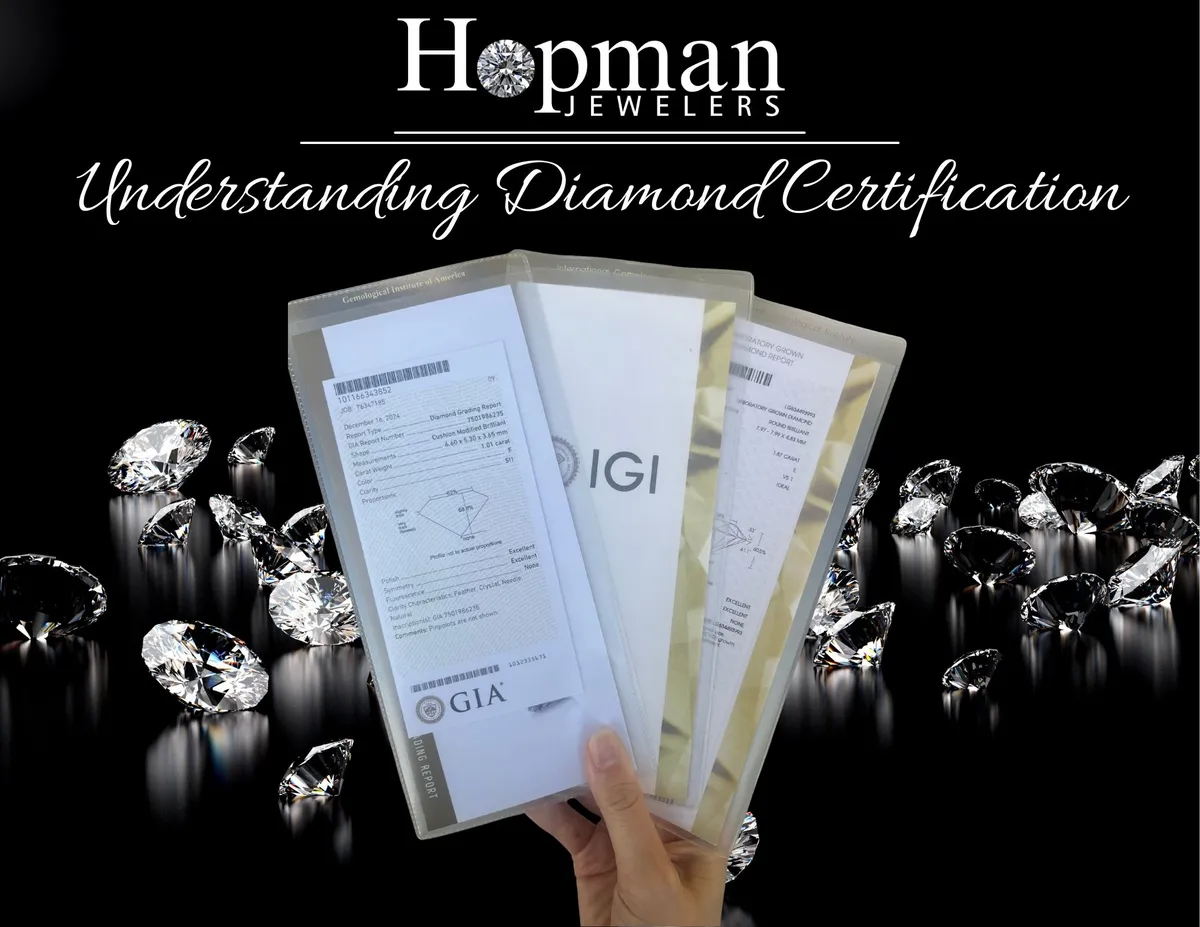Diamonds
Understanding Diamond Certification: GIA, IGI, EGL and What They Mean
Published: Aug 26, 2025

Understanding Diamond Certification: GIA, IGI, EGL and What They Mean
When you’re shopping for a diamond, you’re not just buying sparkle, you’re investing in something that should last a lifetime. That’s why diamond certification is so important. A certificate (or grading report) is an unbiased, professional evaluation of a diamond’s characteristics, including the famous 4Cs: cut, color, clarity, and carat weight. But not all certifications are equal.
At Hopman Jewelers, we believe knowledge is power. Here’s what you need to know about the most common diamond grading laboratories, GIA, IGI, and EGL, and how our in-house GIA Graduate Gemologist expertise sets us apart.
What is Diamond Certification?
A diamond certificate is issued by a gemological laboratory after the diamond has been thoroughly examined. This report describes the diamond’s quality, often including measurements, proportions, and any identifying features. It acts as a “fingerprint” of the stone, giving you peace of mind about what you’re buying.
Many certificates also include a laser inscription on the diamond’s girdle. This microscopic engraving (visible only under magnification) includes the report number and sometimes a brand or logo. It’s a permanent way to match the physical diamond to its paperwork, adding another layer of security and confidence for the buyer.
How Diamonds Are Graded
The grading process is meticulous and involves multiple experts to ensure consistency:
GIA (Gemological Institute of America)
The GIA is the most respected and widely recognized authority in diamond grading. Established in 1931, GIA created the 4Cs system and remains the global standard for accuracy and consistency.
IGI (International Gemological Institute)
The IGI is another well-known lab, particularly for lab-grown diamonds. Many retailers use IGI certificates because they are widely recognized and often provide quicker turnaround times.
EGL (European Gemological Laboratory)
The EGL has a long history in the industry but is known for having looser grading standards compared to GIA or IGI.
Why Certification Matters
Diamond certification gives you:
How Hopman Jewelers Sets You Apart
At Hopman Jewelers, we don’t just sell diamonds, we educate our customers. With a GIA Graduate Gemologist on staff, you’ll receive expert guidance in understanding certifications and how they impact both beauty and value.
Whether you’re looking for a natural diamond, a lab-grown stone, or an estate piece, we’ll help you read the fine print and choose with confidence.
The Bottom Line
Not all diamond certificates are equal. GIA sets the standard for strict, unbiased grading. IGI is reliable and especially common for lab-grown diamonds. EGL may offer diamonds at lower prices but with grading inconsistencies to be aware of.
When you shop at Hopman Jewelers, you’ll benefit from professional expertise and a commitment to honesty, ensuring your diamond is as brilliant on paper as it is in person.
When you’re shopping for a diamond, you’re not just buying sparkle, you’re investing in something that should last a lifetime. That’s why diamond certification is so important. A certificate (or grading report) is an unbiased, professional evaluation of a diamond’s characteristics, including the famous 4Cs: cut, color, clarity, and carat weight. But not all certifications are equal.
At Hopman Jewelers, we believe knowledge is power. Here’s what you need to know about the most common diamond grading laboratories, GIA, IGI, and EGL, and how our in-house GIA Graduate Gemologist expertise sets us apart.
What is Diamond Certification?
A diamond certificate is issued by a gemological laboratory after the diamond has been thoroughly examined. This report describes the diamond’s quality, often including measurements, proportions, and any identifying features. It acts as a “fingerprint” of the stone, giving you peace of mind about what you’re buying.
Many certificates also include a laser inscription on the diamond’s girdle. This microscopic engraving (visible only under magnification) includes the report number and sometimes a brand or logo. It’s a permanent way to match the physical diamond to its paperwork, adding another layer of security and confidence for the buyer.
How Diamonds Are Graded
The grading process is meticulous and involves multiple experts to ensure consistency:
- Initial Examination: Diamonds are received, cleaned, and placed in secure, anonymous packaging so graders do not know where the diamond came from or who owns it.
- Measurement & Proportioning: Advanced tools measure carat weight, table size, depth, angles, and other proportions that impact cut quality.
- Clarity Grading: Under magnification, graders map internal inclusions and external blemishes, noting size, type, and location.
- Color Assessment: Diamonds are compared under controlled lighting against master stones to determine color grade.
- Cut Evaluation: Symmetry, polish, and proportions are analyzed to assess how well the diamond returns light.
- Multiple Reviewers: At labs like GIA, at least two or three independent graders review each stone. A senior gemologist confirms the final grade, ensuring no single opinion determines the result.
GIA (Gemological Institute of America)
The GIA is the most respected and widely recognized authority in diamond grading. Established in 1931, GIA created the 4Cs system and remains the global standard for accuracy and consistency.
- Reputation: Known as the gold standard in diamond grading.
- Accuracy: Consistently strict, reliable, and trusted worldwide.
- Consumer Confidence: When you see a GIA certificate, you know the diamond has been evaluated without bias.
IGI (International Gemological Institute)
The IGI is another well-known lab, particularly for lab-grown diamonds. Many retailers use IGI certificates because they are widely recognized and often provide quicker turnaround times.
- Reputation: Solid in the marketplace, especially for lab-grown diamonds.
- Grading Standards: Considered accurate, though sometimes not as strict as GIA.
- Accessibility: IGI reports are clear, detailed, and customer-friendly.
EGL (European Gemological Laboratory)
The EGL has a long history in the industry but is known for having looser grading standards compared to GIA or IGI.
- Reputation: Controversial; some EGL labs grade more leniently, which can make diamonds appear higher quality on paper than they actually are.
- Grading Standards: Less consistent, which can lead to confusion for buyers.
- Pricing Impact: Because grading can be more generous, EGL-certified diamonds often appear to be “deals,” but may not hold the same long-term value.
Why Certification Matters
Diamond certification gives you:
- Confidence in knowing exactly what you’re buying.
- Transparency so you can compare stones fairly.
- Value protection if you ever resell or upgrade your diamond.
- Trust that your investment matches what’s on paper.
How Hopman Jewelers Sets You Apart
At Hopman Jewelers, we don’t just sell diamonds, we educate our customers. With a GIA Graduate Gemologist on staff, you’ll receive expert guidance in understanding certifications and how they impact both beauty and value.
Whether you’re looking for a natural diamond, a lab-grown stone, or an estate piece, we’ll help you read the fine print and choose with confidence.
The Bottom Line
Not all diamond certificates are equal. GIA sets the standard for strict, unbiased grading. IGI is reliable and especially common for lab-grown diamonds. EGL may offer diamonds at lower prices but with grading inconsistencies to be aware of.
When you shop at Hopman Jewelers, you’ll benefit from professional expertise and a commitment to honesty, ensuring your diamond is as brilliant on paper as it is in person.
